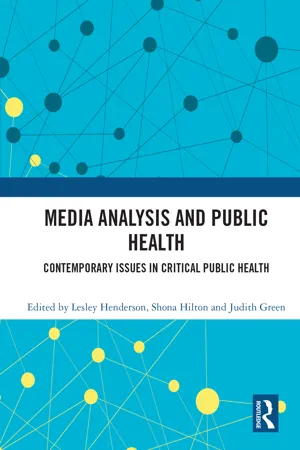
Media Analysis and Public Health
Contemporary Issues in Critical Public Health
- 132 pages
- English
- ePUB (mobile friendly)
- Available on iOS & Android
Media Analysis and Public Health
Contemporary Issues in Critical Public Health
About This Book
This volume showcases new approaches to studying public health in traditional and emerging media, suggesting that we need more analyses that focus on the production of media and on power dynamics, as well as studies of audience reception of media messages.
The collection asks a variety of questions about the role of media in analysing public health. Contributors ask: who is influential in producing the stories we see in the press and on social media? Who benefits, and who is damaged, by media debates on health topics? They investigate the role of big business in seeking to shape public opinion and consumption in print and online media; how issues such as hand washing come to be framed over time by newspapers; how conflicts over immunisations get covered; how health promotion messages do their work; and the positive role of online media in helping foster drug safety. Together, they reach the conclusion that since mass media is a crucial element of civic society, more in-depth understanding of how it works and what impacts it has on public health is essential.
Given the crucial role of the media in shaping health debates, pushing certain issues up the policy agenda, defining problems for audiences and presenting potential solutions, this book's analysis will be of interest to all those studying how the media shape policy, as well as public health researchers with an interest in mass communication. This book was originally published as a special issue of Critical Public Health.
Frequently asked questions
1 How the food, beverage and alcohol industries presented the Public Health Responsibility Deal in UK print and online media reports
Nick Douglas, Cecile Knai, Mark Petticrew, Elizabeth Eastmure, Mary Alison Durand and Nicholas Mays
ABSTRACT
Introduction
Methods
Searching
Screening
1.1. Summary of methods | |
Search | • Dates of searches: March 2015 • Dates of articles: 31/10/10 and 28/2/15 • Search terms: ‘Public Health Responsibility Deal’ or ‘responsibility deal’ • Databases searched: LexisNexis and ProQuest • Websites searched: BBC News, Channel 4 News, Sky News |
Screening | • Full text downloaded to Endnote 7 • Duplicates – removed • Articles with no specific references to the RD – removed • Articles with no quotations about the RD – removed • Two researchers independently screened articles according to selection criteria – see 1.2 • 10% discrepancy in designation of articles identified – resolved following review and discussion without need for review by third researcher |
Coding and textual analysis | • Articles categorised 3 or 4 imported into NVivo 10 • Articles read in full • Quotations from each article extracted – name of the speaker and organisational attribution (where given) recorded • Coding conducted according to principles of Braun and Clarke’s (2006) approach to thematic analysis by first author • 20% of thematic coding reviewed by second author – no discrepancies identified |
1.2. Article categorisation criteria | |
| 1. Not substantively about the RD 2. Is about the RD but contains no quotes 3. Not substatively about the RD but does contain quotes about it. (Articles were also ranked 3 where there was reference to the RD but quotes referred to ‘voluntary agreements’ or where the context made it explicit that the person quoted was referring to the RD even if the specific phrase RD was not used.) 4. Substantively about the RD and contains quotes about the RD | |
Coding and analysis
Findings
These pledges represent a great start to what we hope will be a long-term shared plan to improve alcohol awareness and reduce alcohol harm. Stefan Orlowski, Heineken (News of the World, 2011 March 13).
Table of contents
- Cover
- Half Title
- Title Page
- Copyright Page
- Table of Contents
- Citation Information
- Notes on Contributors
- Preface: Media, Evidence and Debate
- Introduction – The media and public health: where next for critical analysis?
- 1 How the food, beverage and alcohol industries presented the Public Health Responsibility Deal in UK print and online media reports
- 2 Public engagement and the role of the media in post-marketing drug safety: the case of Eltroxin® (levothyroxine) in New Zealand
- 3 How alcohol marketing engages users with alcohol brand content on Facebook: an Indian and Australian perspective
- 4 ‘To drink or not to drink’: media framing of evidence and debate about alcohol consumption in pregnancy
- 5 Working up a lather: the rise (and fall?) of hand hygiene in Canadian newspapers, 1986–2015
- 6 Diet, exercise…and drugs: social constructions of healthy lifestyles in weight-related prescription drug advertisements
- 7 ‘I cannot explain it. I knew it was wrong’: a public account of cigarette smoking in pregnancy
- 8 Perception and translation of numbers: the case of a health campaign in Denmark
- 9 Newspaper coverage of childhood immunisation in Australia: a lens into conflicts within public health
- 10 Is social isolation a public health issue? A media analysis in Aotearoa/New Zealand
- Index